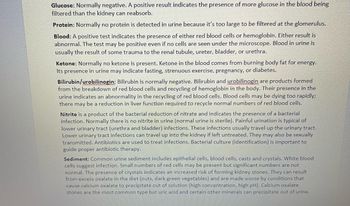1. Why does the volume and color of urine produced by the kidneys vary so much? 2. Why does urine always contain urea? 3. Why are glucose and amino acids reabsorbed in the nephron? ( 4. Why can't the kidney just excrete the filtered plasma without adjusting its content? its Glucose: Normally negative. A positive result indicates the presence of more glucose in the blood being filtered than the kidney can reabsorb. Protein: Normally no protein is detected in urine because it's too large to be filtered at the glomerulus. Blood: A positive test indicates the presence of either red blood cells or hemoglobin. Either result is abnormal. The test may be positive even if no cells are seen under the microscope. Blood in urine is usually the result of some trauma to the renal tubule, ureter, bladder, or urethra. Ketone: Normally no ketone is present. Ketone in the blood comes from burning body fat for energy. Its presence in urine may indicate fasting, strenuous exercise, pregnancy, or diabetes. Bilirubin/urobilinogin: Bilirubin is normally negative. Bilirubin and urobilinogin are products formed from the breakdown of red blood cells and recycling of hemoglobin in the body. Their presence in the urine indicates an abnormality in the recycling of red blood cells. Blood cells may be dying too rapidly; there may be a reduction in liver function required to recycle normal numbers of red blood cells. Nitrite is a product of the bacterial reduction of nitrate and indicates the presence of a bacterial infection. Normally there is no nitrite in urine (normal urine is sterile). Painful urination is typical of lower urinary tract (urethra and bladder) infections. These infections usually travel up the urinary tract. Lower urinary tract infections can travel up into the kidney if left untreated. They may also be sexually transmitted. Antibiotics are used to treat infections. Bacterial culture (identification) is important to guide proper antibiotic therapy. Sediment: Common urine sediment includes epithelial cells, blood cells, casts and crystals. White blood cells suggest infection. Small numbers of red cells may be present but significant numbers are not normal. The presence of crystals indicates an increased risk of forming kidney stones. They can result from excess oxalate in the diet (nuts, dark green vegetables) and are made worse by conditions that cause calcium oxalate to precipitate out of solution (high concentration, high pH). Calcium oxalate stones are the most common type but uric acid and certain other minerals can precipitate out of urine.
1. Why does the volume and color of urine produced by the kidneys vary so much? 2. Why does urine always contain urea? 3. Why are glucose and amino acids reabsorbed in the nephron? ( 4. Why can't the kidney just excrete the filtered plasma without adjusting its content? its Glucose: Normally negative. A positive result indicates the presence of more glucose in the blood being filtered than the kidney can reabsorb. Protein: Normally no protein is detected in urine because it's too large to be filtered at the glomerulus. Blood: A positive test indicates the presence of either red blood cells or hemoglobin. Either result is abnormal. The test may be positive even if no cells are seen under the microscope. Blood in urine is usually the result of some trauma to the renal tubule, ureter, bladder, or urethra. Ketone: Normally no ketone is present. Ketone in the blood comes from burning body fat for energy. Its presence in urine may indicate fasting, strenuous exercise, pregnancy, or diabetes. Bilirubin/urobilinogin: Bilirubin is normally negative. Bilirubin and urobilinogin are products formed from the breakdown of red blood cells and recycling of hemoglobin in the body. Their presence in the urine indicates an abnormality in the recycling of red blood cells. Blood cells may be dying too rapidly; there may be a reduction in liver function required to recycle normal numbers of red blood cells. Nitrite is a product of the bacterial reduction of nitrate and indicates the presence of a bacterial infection. Normally there is no nitrite in urine (normal urine is sterile). Painful urination is typical of lower urinary tract (urethra and bladder) infections. These infections usually travel up the urinary tract. Lower urinary tract infections can travel up into the kidney if left untreated. They may also be sexually transmitted. Antibiotics are used to treat infections. Bacterial culture (identification) is important to guide proper antibiotic therapy. Sediment: Common urine sediment includes epithelial cells, blood cells, casts and crystals. White blood cells suggest infection. Small numbers of red cells may be present but significant numbers are not normal. The presence of crystals indicates an increased risk of forming kidney stones. They can result from excess oxalate in the diet (nuts, dark green vegetables) and are made worse by conditions that cause calcium oxalate to precipitate out of solution (high concentration, high pH). Calcium oxalate stones are the most common type but uric acid and certain other minerals can precipitate out of urine.
Oh no! Our experts couldn't answer your question.
Don't worry! We won't leave you hanging. Plus, we're giving you back one question for the inconvenience.
Submit your question and receive a step-by-step explanation from our experts in as fast as 30 minutes.
You have no more questions left.
Message from our expert:
It looks like you may have submitted a graded question that, per our Honor Code, experts cannot answer. We've credited a question to your account.
Your Question:
How can we answer these questions?

Transcribed Image Text:1. Why does the volume and color of urine produced by the kidneys vary so much?
2. Why does urine always contain urea?
3. Why are glucose and amino acids reabsorbed in the nephron? (
4. Why can't the kidney just excrete the filtered plasma without adjusting its content?
its

Transcribed Image Text:Glucose: Normally negative. A positive result indicates the presence of more glucose in the blood being
filtered than the kidney can reabsorb.
Protein: Normally no protein is detected in urine because it's too large to be filtered at the glomerulus.
Blood: A positive test indicates the presence of either red blood cells or hemoglobin. Either result is
abnormal. The test may be positive even if no cells are seen under the microscope. Blood in urine is
usually the result of some trauma to the renal tubule, ureter, bladder, or urethra.
Ketone: Normally no ketone is present. Ketone in the blood comes from burning body fat for energy.
Its presence in urine may indicate fasting, strenuous exercise, pregnancy, or diabetes.
Bilirubin/urobilinogin: Bilirubin is normally negative. Bilirubin and urobilinogin are products formed
from the breakdown of red blood cells and recycling of hemoglobin in the body. Their presence in the
urine indicates an abnormality in the recycling of red blood cells. Blood cells may be dying too rapidly;
there may be a reduction in liver function required to recycle normal numbers of red blood cells.
Nitrite is a product of the bacterial reduction of nitrate and indicates the presence of a bacterial
infection. Normally there is no nitrite in urine (normal urine is sterile). Painful urination is typical of
lower urinary tract (urethra and bladder) infections. These infections usually travel up the urinary tract.
Lower urinary tract infections can travel up into the kidney if left untreated. They may also be sexually
transmitted. Antibiotics are used to treat infections. Bacterial culture (identification) is important to
guide proper antibiotic therapy.
Sediment: Common urine sediment includes epithelial cells, blood cells, casts and crystals. White blood
cells suggest infection. Small numbers of red cells may be present but significant numbers are not
normal. The presence of crystals indicates an increased risk of forming kidney stones. They can result
from excess oxalate in the diet (nuts, dark green vegetables) and are made worse by conditions that
cause calcium oxalate to precipitate out of solution (high concentration, high pH). Calcium oxalate
stones are the most common type but uric acid and certain other minerals can precipitate out of urine.
Knowledge Booster
Learn more about
Need a deep-dive on the concept behind this application? Look no further. Learn more about this topic, biology and related others by exploring similar questions and additional content below.Recommended textbooks for you

Human Biology (MindTap Course List)
Biology
ISBN:
9781305112100
Author:
Cecie Starr, Beverly McMillan
Publisher:
Cengage Learning

Comprehensive Medical Assisting: Administrative a…
Nursing
ISBN:
9781305964792
Author:
Wilburta Q. Lindh, Carol D. Tamparo, Barbara M. Dahl, Julie Morris, Cindy Correa
Publisher:
Cengage Learning

Human Physiology: From Cells to Systems (MindTap …
Biology
ISBN:
9781285866932
Author:
Lauralee Sherwood
Publisher:
Cengage Learning

Human Biology (MindTap Course List)
Biology
ISBN:
9781305112100
Author:
Cecie Starr, Beverly McMillan
Publisher:
Cengage Learning

Comprehensive Medical Assisting: Administrative a…
Nursing
ISBN:
9781305964792
Author:
Wilburta Q. Lindh, Carol D. Tamparo, Barbara M. Dahl, Julie Morris, Cindy Correa
Publisher:
Cengage Learning

Human Physiology: From Cells to Systems (MindTap …
Biology
ISBN:
9781285866932
Author:
Lauralee Sherwood
Publisher:
Cengage Learning

Biology 2e
Biology
ISBN:
9781947172517
Author:
Matthew Douglas, Jung Choi, Mary Ann Clark
Publisher:
OpenStax


